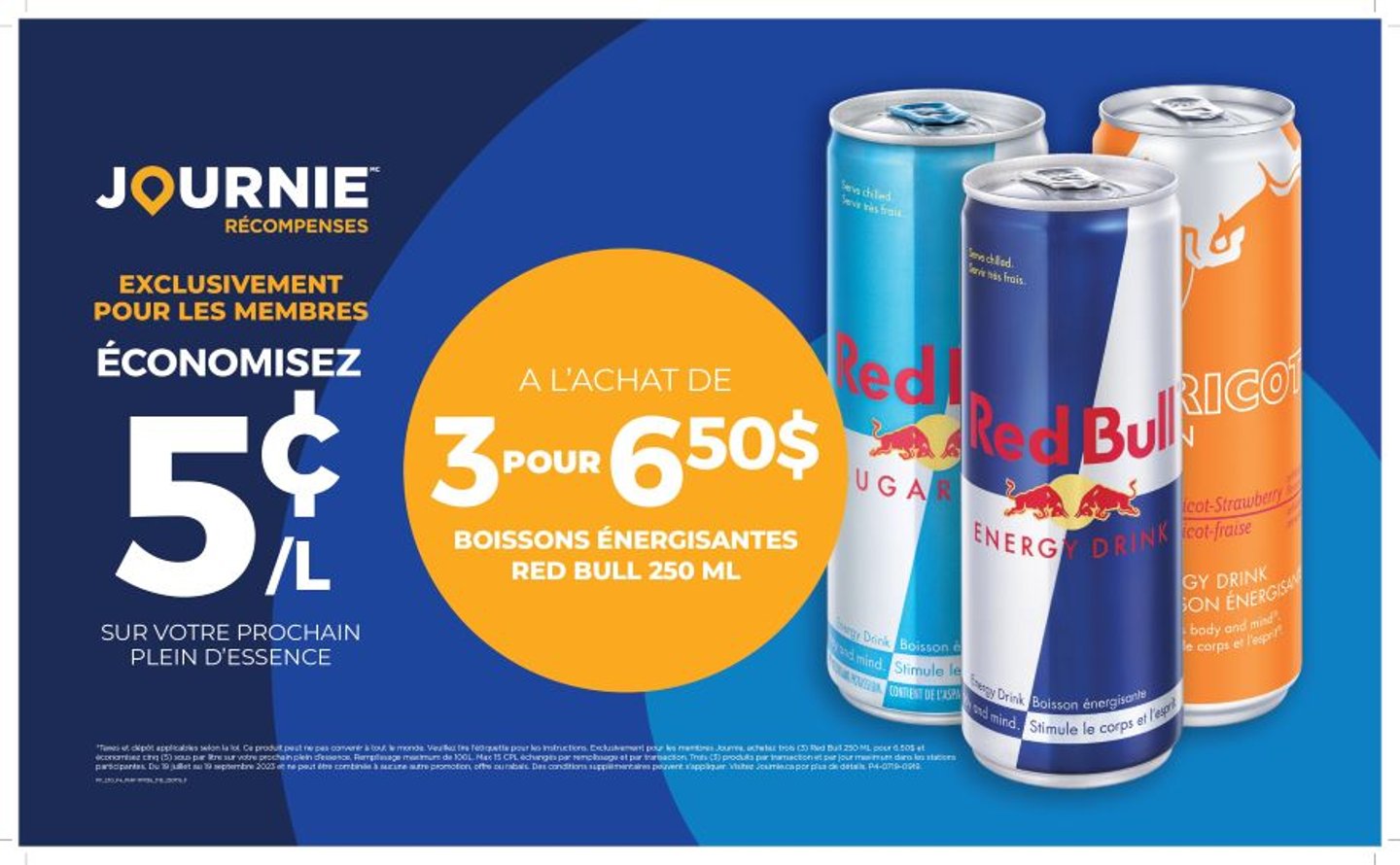For the love of loyalty
PC Optimum. Aeroplan. Scene+. Air Miles. These Canadian customer loyalty programs are household names, while newer programs, like MyMcDonald’s Rewards, which fast-food giant McDonald’s launched across Canada in November 2021, are global platforms.
Canadians love being rewarded for their loyalty. According to KPMG, Canadians rank as the world’s third most active users of loyalty programs (with 56% of the population earning rewards at least a few times a week). The potential bottom-line benefits are big, too: McKinsey reports that top-performing loyalty schemes boost annual revenue among customers who regularly redeem by 15% to 25% through increasing their purchase frequency or basket size or both.
Yet, according to the 2023 C-store IQ National Shopper Study, only one-in-three (30%) shoppers report actively using a convenience store rewards program.
The big chains have doubled down on strategies to increase loyalty program enrolment and engagement, given the ROI they see from active members. POS platforms, meanwhile, are helping smaller operators get in on the loyalty love (see sidebar).
Parkland’s loyalty journey
Parkland launched Journie Rewards in 2019, and in July the program surpassed two million fully enrolled members. “It has grown really quickly,” says Michael McDowell, vice-president, loyalty and partnerships at Parkland. “About one in every five transactions is from a loyalty member. Although we have grown that rate very quickly, it shows the opportunity for accelerated member acquisition.”
This includes in the forecourt and the c-store, where the percentage of customers who are loyalty members making purchases without fuel lags customers making in-store purchases with fuel. “And so, non-fuel customers are a group we’re particularly focused on increasing participation in the program,” says McDowell, who joined Parkland in early 2023 from Bond Brand Loyalty, where he was part of the consulting team that Parkland hired to help create Journie.
Parkland, which operates c-store brands On the Run and Quebec-based Marché Express, as well as the new Bites On the Run, is focused on two strategies. One is promotional pricing partnerships with vendors that give c-store shoppers bonus Journie points towards fuel purchases.
“We just ran a promo where on a purchase of three Red Bulls, a Journie customer earns a five cent CPL discount off their next fill-up,” says McDowell, noting the standard earn on c-store purchases is two points per dollar. “It was a unique promotion in that we used highly valued discounts on CPL as the carrot for c-store purchases."
In addition to signing up new members, product flew off shelves, “so much so that Red Bull signed up for a second campaign, which is in market now,” he says. “Coca-Cola has also signed up for a similar campaign."
Parkland has also brokered an innovative alliance with Aeroplan; rather than simply an earn-and-burn arrangement, it will enable customers this fall to link their Journie memberships to Aeroplan.
“It gives us access to a new set of potential members faster than we would have been able to get on our own,” says McDowell. “Aeroplan members will see it’s worth joining Journie Rewards because of the incremental benefits. An Aeroplan customer using our Journie app to purchase a car wash, purchase food or charge their electric vehicle, for instance, will have the choice to earn and redeem Aeroplan points."
The partnership is like the one Parkland has with CIBC, in which the financial institution’s customers can link to Journie and get 3 cents off CPL on every purchase of fuel. “It has been a massive engagement driver, with CIBC-linked members among our most valuable members,” says McDowell. “We feel we will see the same value from our Aeroplan-linked members.”
With both arrangements, he notes, “we retain and grow Journie’s brand equity while maintaining access to the customer data.” McDowell says the goal is to engage customers in highly personalized offers based on past purchasing behaviour. “We’re in data collection mode right now, but as we modernize our martech capabilities, that’s next,” he promises. “We may find customers, for instance, who purchase specific things are more likely to buy a salty snack, and so we can make an offer based on that insight.”
Needs embraces loyalty scene
This past August, Empire celebrated the one-year anniversary of its 147 Needs Convenience stores in Atlanta Canada switching from Air Miles to Scene+. “In this time, we have seen significant increases in program awareness, satisfaction and membership,” says Shawn Bloom, VP, loyalty at Empire, which became co-owner of the Scene+ program operated by Cineplex and Scotiabank last year.
Today, “three out of four regular Needs Convenience customers are now members of Scene+ and they are some of our most active members using the program to collect and redeem— almost eight times per month.”
Bloom says the challenge convenience stores have traditionally faced with customer adoption has been lower transaction sizes. “While convenience stores can have high purchase frequency, the average transaction sizes are typically small relative to a full-service grocery shop, for example. As a result, some people struggle with whether the time to sign up and participate is worth their while,” he says. “One of the great things about the introduction of Scene+ at Needs Convenience is that points can be earned in a variety of locations, including our Sobeys, Foodland and Lawtons stores, plus at other Scene+ partners like Cineplex and Scotiabank and soon at Home Hardware.”
There is another reason why Empire wants more in-store customers to be Scene+ members.
“The more the program is used, the more we learn about customers’ shopping preferences,” points out Bloom, in turn “allowing us to optimize our merchandising mix and develop more relevant and impactful promotional plans. Moving forward, this means that customers can expect to see more personalized offers, exciting integrations into key Needs Convenience programs like ‘Candy Zone’ or ‘Xtra Slush’ to encourage trial and repeat visits and a broader assortment of valuable supplier promotions on-shelf.”
7-Eleven creates enticing offers
Marc Goodman, 7-Eleven Canada’s VP and general manager, says customers who have downloaded its 7Rewards loyalty app “are more engaged with our brand and tend to shop more often at 7-Eleven.”
Engagement is driven by marketing, merchandising and operations (consistently asking customers if they are members to either drive new enrolments or scan their virtual barcode).
When it comes to merchandising, Goodman says 7-Eleven Canada has been “creating strong offers with our partners whether it’s member-only pricing, bonus points or ‘money-can’t-buy unique experiences’ to incentivize usage.”
Its “360 Summer Fuel Your Play” contest, for example, offered prizes like trips across Canada, summer gear and a million 7Rewards points, with seven partner products (Prime, Ben & Jerry’s, Coca-Cola, Gatorade, Doritos, Kinder Bueno Minis and Jack Link’s), plus Slurpee and 7Select private brands. “Members earned multiple entries into the contest for scanning these products,” says Goodman. “Our rewards program is the engine that drives campaigns, linking partner product purchase to entries in contests and experiences. This gives multiple partners and proprietary products increased visibility and provides incentive to purchase.”
Today, loyalty programs have become the heart of a c-store’s marketing and promotions with brands, and a customer intelligence tool for merchandising. And they’re clearly just scratching the surface of a loyalty program’s power.
Helping smaller players get in on the action
“Most programs we’ve had presented to us are simply discount programs,” says Kevin De Spiegelaere, COO of Little Short Stop Stores in southwestern Ontario. “The cost of implementing a program that involves further discounting our already slim margins is a challenge for a smaller company like us.”
“Without a solution that integrates into our POS system, the logistics and complexity of implementation are discouraging,” he says of another significant challenge.
Thankfully, more options appear to be launching in the Canadian marketplace to help stores move beyond stamp cards and into gleaning actionable customer data. Donnie Fairbanks, a senior strategist at Paytronix, which provides engagement solutions and loyalty programs for convenience stores, says, in fact, there are “a range of loyalty options that exist.”
“Truthfully, aggregate impact of a loyalty program can be difficult to measure without advanced analytics, therefore many brands consider only the cost, not the impact on customer retention and lifetime value,” he explains why so many smaller brands have been hesitant to get in the loyalty train. However, “simple, well-structured programs that are woven into all marketing efforts and diligently optimized over time can be bootstrapped and still amazingly effective at driving short and long-term incrementality.”
Of all the models out there, he recommends an automatic conversion model which rewards consumers with either fuel discounts or store value based on spend levels. “An example would be a points-based program with automatic conversion, like one that may have a customer earn 100 points to receive 10 cents off per gallon,” says Fairbanks. “The economies of this model are self-balancing, have high perceived value, are simple to understand, and require no catalogue development.”
A rewards catalogue features a list of products that can be purchased with points, but Fairbanks says that requires a lot of associate and customer training/education, which smaller chains may not be able to support.
In terms of marketing, Fairbanks advises, “convert discount pricing to loyalty exclusive benefits, by using existing shelf tags but change them to ‘member exclusive.’” He says this is the better way to go because it recognizes “loyalty is not a campaign or a promotion. It is a long-term commitment to the customer relationship that is the most direct route to true connection of any of the marketing tools available.”
POS management platforms now include loyalty-add on options. For instance, Newark, N.J.-based National Retail Solutions launched this year in Canada with a platform for independents that includes a premium feature for a store to implement a “BUY X – GET 1 FREE” club program and/or to award the customer loyalty points.
Ackroo, based in Hamilton, Ont., offers customizable points and currency-based rewards programs starting at $150 per month. Set-up of its loyalty marketing platform for a four-location chain, as an example, which includes a gift card offering and mobile app, costs just $2,000.
Rather than points-based instant discounts for loyalty, “what has become more common is currency-based rewards schemes accrued over time for redemption,” says Steve Levely, CEO of Ackroo.
“You can then use the platform to ladder on various promotions, whether it be by product or time of day, to drive purchases on higher-margin products or turn slow days into busier days,” says Levely. “Even if half your customers come 10% to 20% more often or spend 10% to 20% more per visit, your revenues will increase by 5% to 10%.”
Benchmarks of success
Fairbanks shares the benchmarks small c-stores should aim for in launching, growing and making a loyalty scheme a success.
Aim for: Four successful sign-ups for every 1,000 non-loyalty checkouts sustained over 12 months. “Signups typically start high then quickly dwindle in the months following launch, but it is imperative to continuously enroll new members to grow the program. Track this at store level,” says Fairbanks, who recommends a program be weaved into all marketing, including existing social channels.
Aim for: Active 90-day participation in the program of roughly 70% of the member base. “You also want a substantial database of segmented/targetable customers that can be leveraged to support vendor-funded programs,” says Fairbanks. This offsets the cost of loyalty program marketing while driving program awareness, sign-ups and perceived value, as well as store traffic and sales.
Aim for: By the end of year one, a retailer should have loyalty engagement of 15% or more as measured by the share of purchases made with a loyalty swipe to make it a success.








